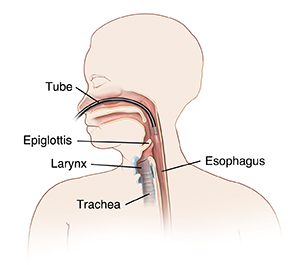Having Fiberoptic Evaluation of Swallowing (FEES)
A fiberoptic evaluation of swallowing (FEES) test is used to see where the problem is in your throat if you have trouble swallowing (dysphagia). Having difficulty swallowing can lead to serious problems, such as aspiration that can lead to a lung infection. During the FEES test, a thin, flexible tool called an endoscope is put into your nose. Parts of your throat are viewed as you swallow. The test is done by a speech-language pathologist (SLP) or an ear, nose, and throat specialist (ENT or otolaryngologist). An SLP has special training in the areas of speech, language, voice, and swallowing.
What to tell your healthcare provider
Tell the SLP about all prescription and over-the-counter medicines you take. This also includes herbs, supplements and any medicine that thins the blood. You may need to stop taking some medicines before the FEES test. Also tell the SLP if you have had any surgery to your neck, throat, or nose.
Getting ready for your FEES test
Before your FEES test, your SLP may want to put you on a special diet. This is to help prevent food or liquids from going into your lungs (aspiration). You should only eat and drink what is on the list from your SLP. The SLP will direct you if there is anything else you need to do to get ready.
During your test
If you are in the hospital, the FEES test may be done in your hospital room. You may also have the test at a healthcare provider's office or clinic. The test often takes around 20 minutes. In general, you can expect the following:
-
During the test, you’ll be seated and awake. Sometimes an anesthetic will be sprayed in your nose so you don’t feel the endoscope. Sometimes it will not be used as it might alter the results of the test if your throat is too numb. That decision will be made by the therapist or other healthcare provider.
-
The SLP puts the endoscope through your nose and down into your throat (pharynx). You may feel mild discomfort. You may have a sense of tightness or gagging. The anesthetic can minimize this.
-
The endoscope sits above your epiglottis for most of the viewing. It then can be moved down after each swallow so the vocal folds may be seen. The endoscope lets your SLP see parts of your voice box (larynx), throat, and windpipe (trachea) on a video screen.
-
The SLP looks at the video screen to see how well you are swallowing and if you are breathing in secretions (aspirating). Your SLP will look at how well secretions are swallowed. They will look at how well breathing and swallowing happen together and how well the airway closes off. They will also be able to see if there are any problems with the shape (anatomy) of your throat.
-
The endoscope may puff small amounts of air into your throat. This is to test the nerves in your throat.
-
You will be asked to swallow small amounts of food or liquids of various thicknesses during the test. These will contain contrast dye so they can be seen on the screen.
-
At the end of the FEES test, the endoscope will be removed from your throat and nose.

After your test
The SLP may tell you the results right away. You may even watch a video of the test. If you had the test in a healthcare provider's office or clinic, you will be able to drive yourself home after the exam. You can probably go back to your normal activities right away.
If you have dysphagia
If your FEES test shows that you have problems swallowing, the SLP will make a treatment plan for you. This is to keep aspiration from happening. You may need to change your diet or to drink only liquids of a certain thickness. You may also need to change your position while you eat. You may learn special mouth exercises and methods to help you swallow. Follow all directions to help you reduce your risk of problems, such as pneumonia from aspiration.
Online Medical Reviewer:
Raymond Kent Turley BSN MSN RN
Online Medical Reviewer:
Rita Sather RN
Online Medical Reviewer:
Sumana Jothi MD
Date Last Reviewed:
12/1/2022
© 2000-2024 The StayWell Company, LLC. All rights reserved. This information is not intended as a substitute for professional medical care. Always follow your healthcare professional's instructions.